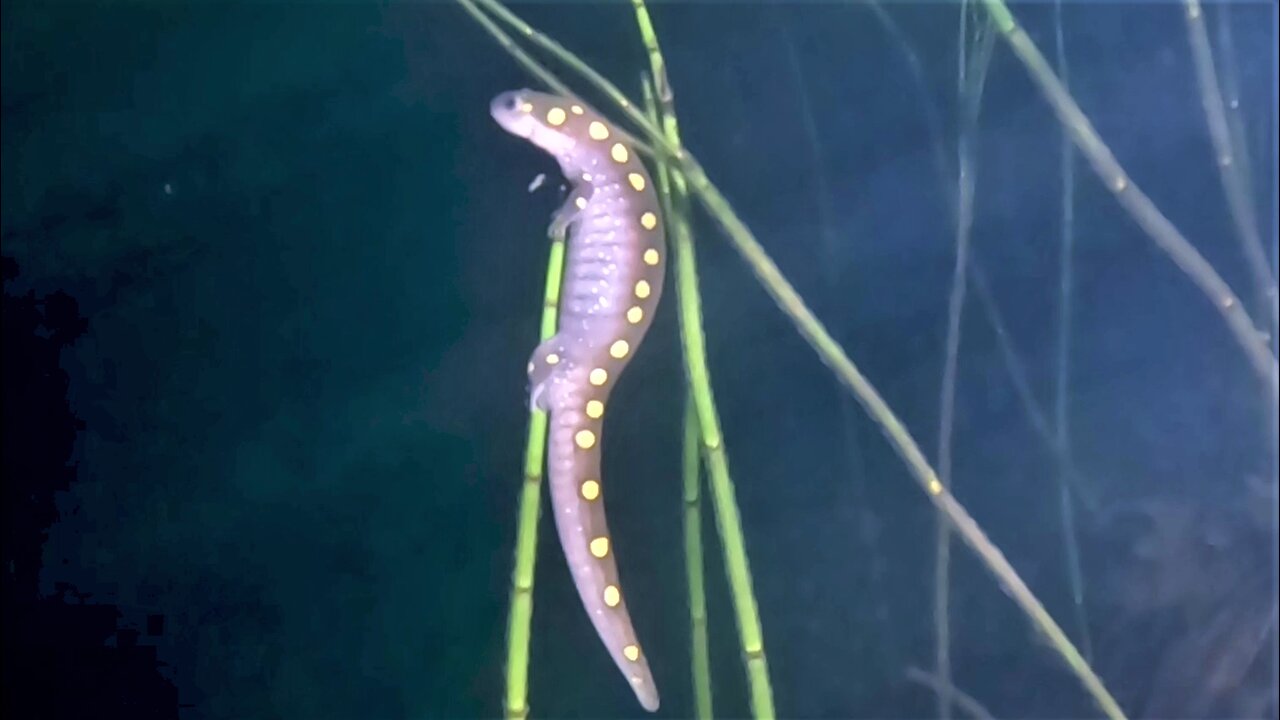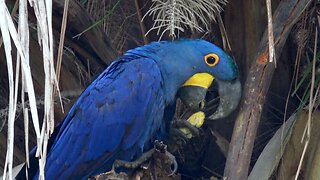Premium Only Content

Salamander lays eggs in secluded forest pond
Yellow spotted salamanders are a rare sight. Although there are great numbers of them in the area surrounding vernal pools in many forests throughout North America, they spend most of their lives burrowed underground. It is rare to catch a glimpse of one out in the open.
But each year, shortly after the ice melts on ponds like this one, the salamanders migrate here in droves, ready to mate and lay eggs underwater. The males arrive first, dropping their spermatophores on the submerged leaves. The females come next, picking up the clusters and taking them into their bodies where the eggs will be fertilized. She then selects a stalk of vegetation or a stick to attach the eggs to.
This videographer went to the local pond each night to watch the salamander migration, the mating frenzy, and the egg laying. It takes place each spring over the course of several days. This female gripped a plant stalk and lay her eggs over the course of 2-3 hours. The eggs emerged and clung to the stalk where they will remain for 6-8 weeks until they hatch.
After the mating is all over, the salamanders leave the pond as abruptly as they arrived. They go back to their refuge under the leaves or the soil, living a solitary life, feeding on worms and insects, until it is time to gather again next spring.
Spotted salamander eggs hatch in 4-8 weeks. The eggs are incredibly unique. The female lays two specific types. In one cluster, the gelatinous mass is a water soluble protein that allows oxygen and carbon dioxide exchange as the embryos develop. The other part of her cluster is surrounded by a gelatinous mass that is made up of a crystalline hydrophobic protein. It inhibits oxygen exchange but these eggs share a symbiotic relationship with an algae that grows within the eggs. The algae produces energy and oxygen through photosynthesis that the embryos use. The carbon dioxide produced by the embryos is consumed by the algae, as is the ammonia produced within the egg. This is the waste product that would harm the eggs. This is the only known true symbiotic relationship between an algae and a vertebrate animal. It is believed that the two types of egg masses will ensure survival in the presence of predators such as wood frogs. The wood frogs will not consume both types of eggs.
Spotted salamanders play an important role in the food chain as they are a major source of food for foxes, raccoons and other forest dwellers.
-
 2:11
2:11
WildCreatures
1 month ago $1.81 earnedBrilliant Blue Hyacinth Macaw Eats Nuts With Impressive Dexterity
18.6K16 -
 2:56:20
2:56:20
FreshandFit
13 hours agoThe Price Is Right! Fresh&Fit After Hours Edition
198K77 -
 6:45
6:45
The Power of Connection
2 days agoThe Power of Connection : Networking vs. Connecting
13K4 -
 28:53
28:53
Afshin Rattansi's Going Underground
3 days agoTrump Has Surrounded Himself With Neocons AGAIN, War After War is Coming! (James Carden)
21.1K20 -
 1:54:50
1:54:50
Badlands Media
12 hours agoDevolution Power Hour Ep. 398: Economic Warfare, Trump’s Strategy, and the Coming Reckoning
77.9K31 -
 2:08:19
2:08:19
Inverted World Live
11 hours agoInvasion of the Lectern Guy | Ep. 124
55.6K6 -
 2:54:29
2:54:29
TimcastIRL
10 hours agoDemocrats Declare STATE OF EMERGENCY Over ICE Raids, DHS ATTACKED, CIVIL WAR | Timcast IRL
254K151 -
 2:37:25
2:37:25
TheSaltyCracker
10 hours agoAlex Jones Gets Screwed ReeEEStream 10-15-25
112K288 -
 58:25
58:25
Man in America
15 hours agoPaper Silver IMPLODES: Experts Predict HUNDREDS PER OUNCE is Coming
49.7K27 -
 5:13:06
5:13:06
Drew Hernandez
17 hours agoSENIOR ISRAELI OFFICIALS CLAIM GAZA WAR NOT OVER & ILLEGAL ALIENS COORDINATE ANOTHER ATTACK ON ICE?
42.5K18